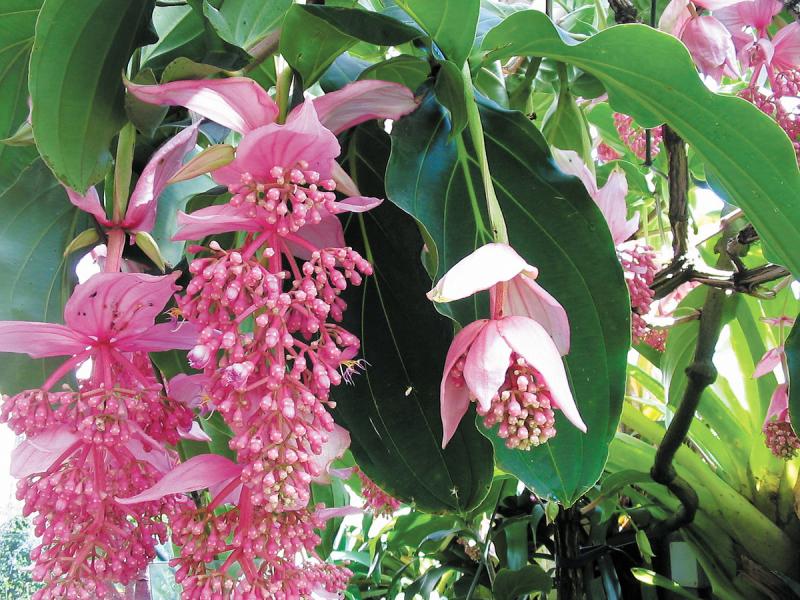New Guinea is an island that is one of the most diverse spots on earth. Near the equator, it has mountains so high that they actually contain year-round equatorial glaciers. Because its landscape is so rugged and very fractured, over 1,000 languages are spoken. One Papuan tribe even lives in tree houses, some nearly 130 feet above the ground. So, the island is home to 195 mammal species found nowhere else on earth, and over 300 endemic bird species. So it is no surprise that we get a new and most interesting houseplant from Papua New Guinea, the Medinilla Gregori Hambali (Medinilla species).
Neon-pink flowers bloom along the upright stems alongside wide, deeply veined leaves with red or purple undersides.
The flowers arise at nodes along the stems, in the same spot that leaves were attached. Best of all, the vibrant pink flower clusters bloom several times a year. Even when those are not in bloom, the puckered leaves with the pink undersides are showy enough.
This is a semi-epiphytic plant, so it gets moisture and nutrients from the air and rain.
This rugged lifestyle makes it a good houseplant because it has such minimal water and soil needs. Always let the soil dry out between waterings. When you do water, add enough so that water drains out the bottom of the pot. Because the plants are semi-epiphytic, pot them in a fast-draining, porous potting mixture such as sphagnum moss. Use clay pots so they can breathe. Keep the humidity above 50 percent for best growth.
You can feed your Medinilla Gregori Hambali when it is actively growing. Use one-quarter teaspoon of liquid fertilizer per gallon of water, and apply no more than once a week.
Do not feed it at all during the winter. Place it in bright shade out of direct sun, an eastern or western exposure. Choose a spot out of drafts where the nighttime temperature is above 50 F. Beauty grows with age, and the flower display gets larger and even more spectacular as your plant matures. If the plant gets too big or lanky, prune it right after it stops blooming.
About the only hard thing about growing a Medinilla Gregori Hambali, (besides pronouncing it) is finding it for sale. You may be able to special order it from a local nursery, or try a mail-order grower such as Logees (www.logees.com) or Brian's Botanicals (www.briansbotanicals.us).
This is one of the most beautiful, showy houseplants around. You can easily grow the Medinilla Gregori Hambali and enjoy it in your home, much like the Papuan tribe living in tree houses 130 feet above the ground. Who, by the way, do this not for the view or the wonderful plants, but to keep out of reach of a neighboring tribe of headhunters.



















































